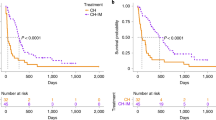Abstract
The purpose of this study was to examine the immunophenotype of canine lymphomas according to the updated Kiel classification adapted for canine species and to relate the immunophenotype to the anatomical classification, clinical stage, and the malignancy. Forty formalin-fixed embedded tissue sections from dogs affected with lymphoma during 2002–2008 at the Department of Veterinary Pathology, Faculty of Veterinary Science, Chulalongkorn University were retrospectively studied. Results indicated that the prevalence of canine lymphoma occurred at the average age of 7.6 years old. Of the total 40 samples, 67.5 % (27/40) and 32.5 % (13/40) were found among pure breeds and mixed breeds, respectively. The tumors were classified by anatomical locations: multicentric (25/40, 62.5 %), mediastinal (2/40, 5.0 %), alimentary (2/40, 5.0 %), extranodal (7/40, 17.5 %), and cutaneous (4/40, 10.0 %). The clinical stages are divided as 7.5 % (3/40), 17.5 % (7/40), 17.5 % (7/40), 45.0 % (18/40), and 12.5 % (5/40) in stages I–V, respectively. Histopathology categorization of the lymphomas into low and high grade was accounted for 34 % (17/40) and 46 % (23/40) cases, in that order. Both immunophenotyping cases were 50 % (20/40) of T-cell (CD3 expression) and B-cell (IgM expression) lymphomas. T-cell phenotype showed higher malignancy than B-cell phenotype.
















Similar content being viewed by others
References
Arespacochaga AG, Schwendenwein I, Weissenbock H (2007) Retrospective study of 82 cases of canine lymphoma in Austria based on working formulation and immunophenotyping. J Comp Pathol 136:186–192
Carter RF, Valli VEO, Lumsden JH (1986) The cytology, histology and prevalence of cell types in canine lymphoma classified according to the National Cancer Institute Working Formulation. Can J Vet Res 50:154–164
Dobson JM (2004) Classification of canine lymphoma: a step forward. Vet J 167:125–126
Dobson J, Samuel S, Milstein H et al (2002) Canine neoplasia in UK: estimate of incidence rates from a population of insured dogs. J Small Anim Pract 43:440–446
Ettinger SN (2003) Principles of treatment for canine lymphoma clinical techniques. J Small Anim Pract 18:92–97
Ferrer L, Fondevila D, Rabanal R et al (1993) Immunohistochemical detection of CD3 antigen (pan T marker) in canine lymphomas. J Vet Diag Invest 5:616–620
Fournel-Fleury C, Magnol JP, Bricaire P et al (1997) Cytohistological and immunological classification of canine malignant lymphomas: comparison with human non-Hodgkin's lymphomas. J Comp Pathol 117:35–59
Fournel-Fleury C, Ponce F, Felman P et al (2002) Canine T-cell lymphomas: morphological, immunological and clinical study of 46 new cases. Vet Pathol 39:92–109
Garret LD, Thamm DH, Chun R (2002) Evaluation of a 6-month chemotherapy protocol with no maintenance therapy for dogs with lymphoma. J Vet Intern Med 16:704–709
Greenlee PG, Filippa DA, Quimby FW (1990) Lymphoma in dogs. A morphologic, immunologic, and clinical study. Cancer 66:480–490
Intragumtornchai T, Wannakrairoj P, Chaimongkol B (1996) Non-Hodgkin's lymphomas in Thailand. A retrospective pathogenic and clinical analysis of 1391 cases. Cancer Res 78:1813–1819
Jaffe ES, Harris NL, Stein H et al (2001) World Health Organization classification of tumours. Pathology and genetics. Tumours of haematopoietic and lymphoid tissues. International Agency for Research on Cancer, Lyon
Madewell BR (1985) Canine lymphoma. Vet Clin North Am Sm Anim Pract 15:709–723
Modiano JF, Breen M, Burnett RC et al (2005) Distinct B-cell and T-cell lymphoproliferative disease prevalence among dog breeds indicates heritable risk. Cancer Res 65:13
Ponce F, Magnol JP, Blavier A et al (2003) Clinical, morphological and immunological study of 13 cases of canine lymphoblastic lymphoma: comparison with the human entity. Comp Clin Path 12:75–83
Ponce F, Magnol J, Ledieu D et al (2004) Prognostic significance of morphological subtypes in canine malignant lymphomas during chemotherapy. Vet J 167:158–166
Rungsipipat A, Sunyasootcharee B, Ousawaphalangchai L et al (2003) Neoplasms of dogs in Bangkok. Thai J Vet Med 33(1):60–66
Ruslander DA, Gebhard DH, Tompkins MB (1997) Immunophenotypic characterization of canine lymphoproliferative disorders. In Vivo 11:169–172
Sueiro FAR, Alessi AC, Vassallo J (2004) Canine lymphomas: a morphological and immunohistochemical study of 55 cases, with observations on p53 immunoexpression. J Comp Path 131:207–213
Teske E, Wisman P, Moore PE et al (1994) Histologic classification and immunophenotyping of canine non-Hodgkin’s lymphomas: unexpected high frequency of T cell lymphomas with B cell morphology. Exp Hematol 22:1179–1187
Thomas R, Smith KC, Gould R et al (2001) Molecular cytogenetic analysis of a novel high grade canine T-lymphoblastic lymphoma demonstrating co expression of CD3 and CD79a cell markers. Chromosome Res 9:649–657
Vail DM, Young KM (2007) Hematopoietic tumors. In: Withrow SJ, Vail DM (eds) Small animal clinical oncology, 3rd edn. Saunders Elsevier, St. Louis, pp 699–716
Valli VE, Jacobs RM, Parodi AL et al (2002) Histological classification of hematopoietic tumors of domestic animals (World Health Organization international histological classification of tumors of domestic animals). Armed Forces Institute of Pathology, Washington
Acknowledgments
This project was supported by the Special Task Force for Activating Research and the Molecular Biology Research on Animal Oncology, Faculty of Veterinary Science, Chulalongkorn University, Bangkok, Thailand.
Author information
Authors and Affiliations
Corresponding author
Rights and permissions
About this article
Cite this article
Rungsipipat, A., Chayapong, J., Jongchalermchai, J. et al. Histopathological classification and immunophenotyping of spontaneous canine lymphoma in Bangkok metropolitan. Comp Clin Pathol 23, 213–222 (2014). https://doi.org/10.1007/s00580-012-1600-9
Received:
Accepted:
Published:
Issue Date:
DOI: https://doi.org/10.1007/s00580-012-1600-9




